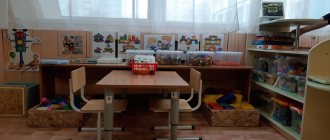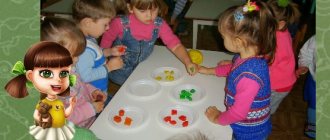“Formation and development of creative abilities of children 6-7 years old through Lego construction”
Municipal Budgetary Preschool Educational Institution
Kindergarten No. 58
Teacher’s self-education plan on the topic: “Formation and development of creative abilities of children 6-7 years old through Lego construction”
for the 2018-2019 academic year
Completed by: Olga Aleksandrovna Napesochnaya
Krasnoyarsk, 2016
Lego construction is a type of productive activity based on creative modeling using a wide range of universal Lego elements. The use of Lego constructors helps to achieve serious educational goals, since in the process of an exciting, creative and educational game, favorable conditions are created that stimulate the comprehensive development of a preschooler in accordance with the requirements of the Federal State Educational Standard
.
Goals:
stimulate children's technical creativity;
teach modeling based on drawings and your own ideas;
develop the ability to independently solve technical problems;
At 6–7 years old, various types of Lego constructors are offered for technical creativity, from large ones with simple connections of elements to the most miniature ones with complex execution techniques. When working with older preschoolers, you can use tasks in the form of graphic diagrams, complicated models of future buildings, work based on design, conditions, and various thematic tasks.
Relevance:
With the help of Lego construction sets, kids can create their own unique world, simultaneously mastering complex mathematical knowledge, developing motor coordination, fine motor skills, and training their eye. Design classes stimulate curiosity, develop imaginative and spatial thinking, activate fantasy and imagination, awaken initiative and independence, as well as interest in invention and creativity. My task
— create the necessary conditions for involving children in an exciting activity that allows them to reveal the potential abilities of their pupils
Forms of implementation of the Lego method in kindergarten:
Scheduled lessons (25–30 minutes in senior and preparatory classes).
Individual work of a teacher in pairs with a child or with a subgroup of children (once a week no more than 40 minutes):
preparing a child for a competition;
working with gifted or underdeveloped children.
Long-term and short-term projects, the participants of which can be children, parents and educators:
Everyday independent design, construction game in free time from scheduled classes.
Festivals, competitions, quizzes.
Working methods and techniques:
The following pedagogical techniques are used in the learning process:
An introductory conversation with the help of which the teacher draws attention to the topic of Lego construction.
Self-education plan on the topic: TRIZ technology in kindergarten.
Transcript
1 MU "COMMITTEE FOR EDUCATION OF THE CITY OF ULAN-UDE" Municipal budgetary preschool educational institution Kindergarten 15 "Rainbow" of the city of Ulan-Ude of a general developmental type, Republic of Buryatia, Ulan-Ude, village. Airport, building 33, tel (fax): 8(3012), Self-education plan on the topic: TRIZ technology in kindergarten. Educator: highest category Burdukovskaya Nadezhda Aleksandrovna. Working period: three years ( ). Results: Introduction of TRIZ technology into all types of children's activities. Every child is initially talented and even brilliant, but he must be taught to navigate the modern world in order to achieve maximum effect with a minimum of costs” (G.S. Altshuller) Goal: 1. Increase your professional level; 2. Deepening knowledge in the field of TRIZ technology for the education of a creative personality prepared for stable solving of non-standard problems in various fields of activity. 3. Introduction of TRIZ technology into all types of children's activities. Objectives: 1. Acquaintance with innovative technologies; 2. Collection of materials on work in teaching activities using TRIZ technology. 3. Introduction of TRIZ technology into all types of children's activities. 4. Master the methods and techniques of TRIZ technology 5. Show the effectiveness of methods and techniques of TRIZ technologies to the entire kindergarten community (children, teachers, parents) 6. Help children master modern methodology for their further use in various types of children's activities, in everyday life, in the future life, I use elements of TRIZ technology. 7.. To develop in children, through play activities, the ability to generate new ideas, deviate from traditional thinking patterns, and quickly solve problem situations.
2 Relevance: In light of the requirements of the Federal State Educational Standard for Education, teachers face one of the main tasks - creating a favorable social situation for the development of the child in accordance with his age and individual characteristics and inclinations, the formation of cognitive interests and creative abilities. And at the moment, all preschool institutions are in search of more effective methods. And now our kindergarten is an internship site for the implementation of Kudryavtseva’s “Paths” program, which is aimed at developing the child’s imagination. Having started working with this program and delving deeper into its methods, in particular the Dienesh blocks, I was prompted to think that somewhere I had already encountered this. I decided to delve deeper into the study and use of TRIZ technology in my work with children, since many techniques are taken from this program. Expected result: 1. Collection of materials and development of work programs for the implementation of TRIZ technology in all types of activities. 2. Introduction of TRIZ technology into all types of children's activities. 3. Children’s mastery of modern methodology for its further use in various types of children’s activities, in everyday life, in future life, using elements of TRIZ technology. 4. Generalization of your experiences. Stages and deadlines for implementation: Stages of implementation Objectives Deadlines Preparatory Diagnostic Practical Generalizing Analytical Study of psychological, pedagogical, methodological literature on the topic of self-education Development of software and methodological support for the educational process Introduction of work experience (working with children, working with parents) Long-term work plan Contents of activities Deadlines Form providing Reading methodological, pedagogical and subject-specific results Studying literature, visiting the Internet -
3 references. Review information on this topic on the Internet. Study books: - Heinrich Altshuller “Find an idea. Introduction to TRIZ theory of solving inventive problems." — Sidorchuk T.A. “Children’s writing of creative stories”, Moscow, 2015. — Sidorchuk T.A. “Methodology for developing classification skills in preschoolers,” Moscow, 2015. — Strauning A. M. “Tasks around us”, Obninsk, p. — Nurmukhametova A. B., Nurmukhametova I. F. “By playing, we develop. By developing we teach”, Naberezhnye Chelny, p. — Shaekhova R.K. “We Think While Playing”, Kazan, p. — Gin S.I. “TRIZ classes in kindergarten: a manual for teachers of preschool institutions” (3rd ed., Minsk, Information Computing Center of the Ministry of Finance, 2007) September 2022. lectures, online seminars and forums on the topic of using TRIZ technology in preschool educational institutions and project activities. Selection of methodological equipment. Drawing up a long-term plan for working with children and introducing technology into all types of children's activities. Develop long-term work plans for all types of activities for different age groups Systematize practical material on this problem At the beginning of the year for three years of the year Calendar and thematic planning Card file of games and activities. Visual material. Seminars and workshops, Selection of literature on
4 open classes, consultations for educators: “Application of TRIZ technology in various types of children’s activities on this topic. Questionnaire Presentations. Recommendations for teachers. Master classes, consultations, business games for parents Development of the author’s program for the “Imaginary” circle Dissemination of one’s experience Diagnosis of children’s work efficiency using TRIZ technology Publication of one’s own experience in teaching activities September 2019 academic year Questionnaire. Recommendations for parents. Visual material. Open Day. Consultations. Long-term planning of the circle Work of the “Imaginary” circle. Methods for determining the level of development of imagination O.M. Dyachenko and A.I. Kirillova, as well as the method of creative thinking by P. Torrance Diagrams. Articles on social networks for teachers and parents. Conclusions for the future: The plans are to solve the most pressing problems today, namely: ensuring the integration of TRIZ into all types of children's activities; creation of the “Imaginary” circle, creation of a system of various forms of interaction with the family in matters of child development according to the TRIZ system, creation of a unified development space. And I would like to think that purposeful, systematic work on the use of TRIZ will help us achieve our goal, and most importantly, prepare the child for developmental schooling, to solve life’s creative problems in such a rapidly changing world. In-depth work in this direction will reveal its effectiveness. The use of this technology in kindergarten will allow preschoolers to develop, on the one hand, such qualities of thinking as flexibility, mobility, systematicity, and dialecticism; on the other hand, search activity, the desire for novelty; speech and creative imagination.
5

